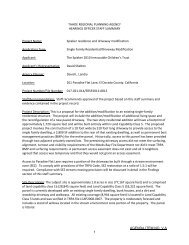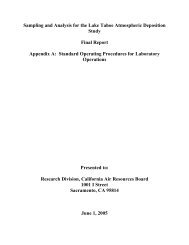FEIS - Tahoe Regional Planning Agency
FEIS - Tahoe Regional Planning Agency
FEIS - Tahoe Regional Planning Agency
You also want an ePaper? Increase the reach of your titles
YUMPU automatically turns print PDFs into web optimized ePapers that Google loves.
RESPONSE TO COMMENTS ON THE DEIS<br />
B o u l d e r B a y C o m m u n i t y E n h a n c e m e n t P r o g r a m P r o j e c t E I S<br />
and 11.1 - Expand bicycle paths and increase opportunities for safe bicycling.<br />
Alternative C will help achieve each of these goals.<br />
Comment 322-v: Comment Summary - Impact LU-2 should show Alt A as No Impact not LTS. This is<br />
true throughout the DEIS (LU-3, GEO-3, GEO-C1, HYDRO-3, -4, and -5, BIO-1, -8,<br />
and -C1, SR-C1, REC-1, -2, -3, and -C1, CUL-2 and -4, SPH-2 and -3, PSU-1, -2, -3,<br />
and -C1).<br />
Use of the terms No Impact and Less than Significant indicate that a significant<br />
impact does not occur and that no mitigation is warranted. Impact LU-2 describes<br />
Alternative A as Less than Significant instead of No Impact because the impact<br />
statement applies to some degree. Consistency with adjacent land uses is something<br />
that exists in this instance and existing land uses do not always comply with<br />
surrounding land uses. Since the existing land uses comply, the impact is less than<br />
significant. If no uses existed onsite, this impact would be No Impact. No Impact is<br />
used when there is no potential for any level of impact. Less than Significant is used<br />
when there may be some level of impact or when there are existing issues as in the<br />
case of HYDRO-3 where BMPs will be utilized to address existing runoff issues<br />
onsite. Since BMPs will be implemented for all Alternatives to bring the site into<br />
compliance, this impact is less than significant, but not No Impact. Another example<br />
is a case where no new impacts occur, but existing impacts persist. For HYDRO-4,<br />
no new impact occurs, but an existing alteration to groundwater persists, resulting in<br />
a less than significant impact instead of No Impact.<br />
Comment 322-w: Comment Summary - Impact LU-2 for Alt. C should not be LTS but SU, with the<br />
ERU/TAU transfers, changes to the Mariner Agreement, and changes to Code.<br />
The transfer of Boulder Bay owned TAUs and ERUs to the project area and the<br />
proposed amendment to the TRPA Code Chapter 22 (height) required for Alternative<br />
C are included as part of the description of the proposed action. In addition, the<br />
project description states that in order to obtain project approval from TRPA, the<br />
existing <strong>Tahoe</strong> Mariner Settlement Agreement must be amended by TRPA and the<br />
CA Attorney General's office. The analysis concludes that the transfer of<br />
TAUs/ERUs and amendment of Code Chapter 22 and the Mariner Settlement<br />
Agreement will not result in significant impacts under Alternative C. The comment<br />
does not specify why Impact LU-2 under Alternative C should be considered<br />
significant and unavoidable.<br />
Comment 322-x: Comment Summary - Provide architectural drawings showing the elevations and size<br />
of the buildings.<br />
Building elevations were not provided in the DEIS because the visual simulations<br />
illustrate the size and appearance of the buildings. TRPA has detailed elevations in<br />
the project file as part of the project application that are available for public review.<br />
However, building elevations are added to the <strong>FEIS</strong> in Appendix AH.<br />
Comment 322-y: Comment Summary - Impact GEO-1 does not analyze actual building use coverage.<br />
Provide the relative footprint of existing conditions as compared to the other<br />
Alternatives. Alt. C building use footprint is greater, but the ratings do not reflect<br />
this.<br />
The Impact GEO-1 analysis follows processes outlined in TRPA Code Section<br />
20.3.D. Land coverage is defined in TRPA Code Chapter 2 as a man-made structure,<br />
improvement or covering that prevents normal precipitation for directly reaching the<br />
surface of the land underlying the structure, improvement or covering. Therefore,<br />
PAGE 8- 86 HAUGE BRUECK ASSOCIATES SEPTEMBER 8 , 2010






